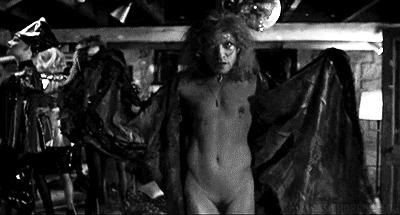
Trans is the New Black
Trans is the new black. It is the hip new thing. Even the Chongas want a piece of it. Yeah…they’re still wearing the translucent Brazilian hot pants with the bright, neon pink thong shining through, but the top is now decidedly masculine. Their babydaddy’s double XL T-shirt matches their kicks. We should have seen it coming. Do not call it a comeback, it’s been here for years.[1] When Al Pacino robbed a bank to pay for his wife’s gender affirming surgery in the seventies, we learned that a man would do anything for love, even if the media portrayed it as a bullshit three ring circus sideshow of freaks.[2] But, while Dog Day Afternoon scraped at the topsoil of compassion in 1975, fast-forward sixteen years, Jonathan Demme took a dump down the throat of trans-normalcy by resurrecting Frankenstein and leading his actors to box office gold.[3] Thankfully, in the recent past, we’ve experienced an uptick in honorable programming and kinder, gentler depictions of transgender people as human beings. The hit Amazon series, Transparent, has won critical acclaim for its heartwarming stories of challenge in the face of adversity, and Hari Nef has been signed as a Gucci girl without any consumer-facing, photographic tells of her transgender identity.
When Hari Nef landed a modelling contract at IMG it was history. She was the first openly transgender woman to sign on the dotted line. Ivan Bart, the president of the agency, was sure that a particular designer for Saint Laurent Paris would dig her. Hari became a Gucci girl and appeared in print ads wearing high-end fashionable things that were far too expensive for the common woman to afford. But, Alessandro Michele, Gucci’s creative director, also put Nef in a menswear show, as a woman (Schulman 2017). Several things are at play here. Michele, as the architect of Gucci’s new “gender-rebellious style which sees girls dressed like nerdy boys and boys like beautiful girls,” is purposefully bending gender stereotypes and presenting cross-dressing models at a fashion show to sell his brand (Petty 2016). By assimilating Nef’s trans-chic cool he hopes to find many new Gucci consumers who agree to buy-in to his gender fluid marketing experiment. Michele is subscribing to this corporate antinomianism by co-opting the rebellion against gender conformity as Gucci’s own ethos. What once would have been thought of as totally subversive is now being touted by the corporation as hip so they can move more units (Frank 1995). What’s at stake here, however, is Hari’s transgender identity. Is it okay to dress up a transwoman as a man and put her on display as a boy? By doing so, is Alessandro Michele publicly discounting Hari Nef’s identity as a woman?[4] There’s nothing carnivalesque about it. We already know who Hari is (Duncombe 2002, p. 88).
In fact, when we see Hari Nef’s character on Transparent, Gittel, forced to take off her dress and put her boy clothes on, we see her suffering in despair. Her adolescent transwoman character has been put to shame. In the past, we worried that the media presents “both women and men in stereotyped ways that limit our perceptions of human possibilities” (Wood 1994, p 32). “In a beautifully filmed sex scene,” in Transparent, however, “Moppa fingers her ex-wife in the bathtub, an act that feels at once transgressive, tender, and cold” (Nussbaum 2017). While the show is a fictionalized tribute to creator Jill Soloway’s experience growing up with a transgender mother (“Moppa,” previously “Poppa”) who came out at the age of seventy-five, Transparent has nevertheless spawned a great deal of discussion as to the most appropriate way to tell a transgender story in the real world.[5]
The first lesson is to cast transgender actors for transgender roles. While Jeffrey Tambor, a cisgender, heterosexual male, has won several Emmys for his role as Maura Pfefferman, the trans-patriarch turned matriarch, Soloway admitted that her greatest regret about the show was casting him as the lead. “Were I to start all over today, it would be unimaginable for me to cast a cis man in the role of a transwoman” (Interviewed in Melas 2016). The issue is, of course, that by handing a trans experience over to a cisgender actor to play out on the screen, one is discounting the role and portrayal in the story, even if he does it well. Parody is inappropriately infused into the performance.[6] Additionally, you are removing one of the few appropriate roles available for a transgender actor to assume. While the producers may be thinking that there is something Carnivalesque about casting Jeffrey Tambor, someone the public knows as a heterosexual male since he began acting on television in 1977, and that the audience will be able to find humor in seeing him cross-dress and more easily relate to a trans experience, the problem remains. Entertainment through television is passive.[7] Carnival is not a spectator sport. Everyone is supposed to be an active participant (Duncombe 2002, p. 86).
In the highly celebrated, five Oscar-winning horror film, The Silence of the Lambs, a female protagonist, Clarice Starling, is on the hunt for the serial killer, Buffalo Bill. In order to get some perspective on where to find the evil doer she has to consult with someone who can relate to Buffalo Bill, and that person can only be Hannibal Lecter, a convicted serial killer cannibal. Despite growing societal inclusion of LGBQ identities, gender culture wars are rampant and manifest in the misrepresentation of transgender people as predators (Chang and Wildman 2017, p. 49-50). When we finally discover who Buffalo Bill is, we learn that he is a transgender maniac that has been skinning his female victims so he can make a dress out of human flesh and feel more like a woman. The motivation appears to be that he had applied for and was rejected from consideration for a sex change operation.[8]
The Silence of the Lambs is a one hundred-and-eighteen minute testimonial tribute to transphobia. Carol Clover describes Buffalo Bill as “a physical adult but a spiritual child, locked in the embrace of his mother,” whose “issue would appear to be not homosexuality and not heterosexuality but the failure to achieve sexuality of any kind” (Clover 2015, p. 233). Sadly, Clover has completely missed the point here, never mentioning gender, which does not imply sexual orientation (Chang and Wildman 2017, p.60). As we watch Buffalo Bill put on makeup, play with his nipple ring and pose in front of a mirror, his penis tucked between his legs, happy to be pretending that for a moment it is gone, we are not allowed to feel an ounce of sympathy or compassion. Director Jonathan Demme has instructed his editor to cut away every few seconds to Bill’s captive in the dirty pit. The audience is constantly reminded that they are watching a monster. There is no explanation for Buffalo Bill’s gender dysphoria, nor society’s denial to allow him to transition. Clover would have you believe that he just can’t achieve an erection.
A decade ago, “transgenero” meant nothing to the general population. Now, the chisme is all about these malcriado gender role defying, cross-dressing maricones featured on television and magazine covers, in theatres and fashion shows. Consumers of popular culture are presented with varying interpretations of gender as society reconciles this newfound visibility in our own barrios. Viewers are forced to contemplate how they express their own gender and reconsider any man-made limitations. While shifting gender norms in mass media allow for inter-communal dialogue that never would have occurred outside of the social and familial circles that already included out transgender individuals, misrepresentation and the perpetuation of harmful caricatures of trans identities negatively impacts the lives of millions.[9] The images that appear in popular culture often represent the viewers’ first impression of the transgender community, and antagonistic, prejudicial portrayals of these human beings can incite violence. The media may entertain us, but they also play an integral role in informing our perspective on new ideas. This is a powerful responsibility. Wielding it recklessly has the potential consequence of retarding society’s progress and costing us lives.
[1] Even LL Cool J knows.
[2] Maynard James Keenan knows (Tool 1997).
[3] Silence of the Lambs was some fucked up shit. I know he didn’t write the story, but he told it on-screen and those Oscar-voting pendejos lapped it up as todos los hijos de puta del mundo emptied their wallets at the theatre.
[4] “My grief lies all within, and these external manners of lament are merely shadows to the unseen grief that swells with silence in the tortured soul” – William Shakespeare. Richard II, Act IV, Scene 1. 325 murders of trans and gender-diverse people were registered last year. 2609 since we started counting in January of 2008 (TMM 2017). This shit is getting out of hand.
[5] For starters, do not tokenize trans characters like that dumbass, Buck, in The OA. This is what gets me…Ian Thompson is actually trans (Bramesco 2016). He’s a legitimate casting for the show, but his character says the mas estupidas trans 101 things that you could ever pay a cis-het cabron to write. It’s amateur hour and comes across as inauthentic, and yet, the dude playing the transdude is a transdude. Fail.
[6] There’s nothing funny about being trans. It ain’t no joke. Out of those 2609 murders, 62% were sex workers (TMM 2017). Por que tantas prostitutas? Because nobody will hire them. Look over at the margin of the marginalized communities…that’s where you’ll find them. Nobody gives a fuck.
[7] True story. Once that puta, Caitlin Jenner, came to the local LGBTQ center: Pridelines. She asked me if I could get all my friends to sign waivers and appear on her punk-ass TV show, I Am Cait…for free. Ese bruja tiene montañas de dinero…100 millones…they say. She doesn’t even believe that gays should be allowed to marry. I told her I would need a donation of 50K for the center or she could fuck off. She fucked off. But Lady Gaga gave us five grand, no exploitation required.
[8] You see it’s this kind of bullshit that foments discord and galvanizes prejudice into actionable crimenes de odio. Buffalo Bill was the first (and for many el unico) transgender person that tens of millions of people met. It was an international blockbuster. And the lasting impression was that these pendejos are fucked up and we need to put them down. Lock up your daughters because these monsters want to skin them alive.
[9] .003 x 7.6 billion = 22.8 million transgender people…more people than all of the rednecks in Alabama, Arkansas, Kentucky, Lousiana & Oklahoma combined. Enough people to make the third largest state in the US of A.
I have written this essay in the style of Junot Diaz.
Works Cited
Bramesco, Charles. “Brit Marling on The OA, Netflix’s Surprise Show About Dying.” Vulture, 19 Dec. 2016.
Chang, Adam R., and Stephanie M. Wildman. “Gender In/sight: Examining Culture and Constructions of Gender.” Geo. J. Gender & L. 18 (2017).
Clover, Carol J. Men, women, and chain saws: Gender in the modern horror film. Princeton University Press, 2015.
Demme, Jonathan, director. The Silence of the Lambs. 1991.
Duncombe, Stephen, ed. Cultural Resistance Reader. Verso, 2002.
Frank, Thomas. “Dark age: why Johnny can’t dissent.” The Baffler6, 1995.
L.L. Cool J. “Going Back to Cali.” Less Than Zero, 1987.
Lumet, Sidner, director. Dog Day Afternoon. Warner Bros., 1975.
Melas, Chloe. “’Transparent’ Creator on Why She’d Cast a Trans Actor in Starring Role Now.” CNN, Cable News Network, 23 Sept. 2016.
Nussbaum, Emily. “The Emotional Acrobats of ‘Transparent.’” The New Yorker, The New Yorker, 18 June 2017.
Petty, Felix. “Hari Nef Stars in Gucci’s Menswear Show.” i-D, Vice, 18 Jan. 2016.
Schulman, Michael. “Hari Nef, Model Citizen.” The New Yorker, 19 June 2017.
TMM. “Transgender Day of Remembrance 2017.” Transrespect.org, Transgender Europe’s Trans Murder Monitoring (TMM).
Tool. “Ænema.” Ænema, 1997.
Wood, Julia T. “Gendered media: The influence of media on views of gender.” Gendered lives: Communication, gender and culture (1994).


